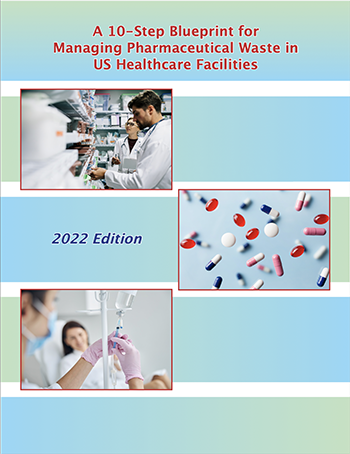 |
For compliance assistance, see: A 10-Step Blueprint for Managing Pharmaceutical Waste in US Healthcare Facilities, 2022 Edition. |
Non-Hazardous Waste Pharmaceuticals
This section covers disposal of pharmaceutical waste that is not regulated under EPA RCRA Subpart C (hazardous waste rules), National Institute for Occupational Safety and Health (NIOSH) or US Drug Enforcement Administration (DEA) regulations. We refer to this material as non-hazardous pharmaceutical waste. Some sources refer to it as non-regulated pharmaceutical waste or non-RCRA pharmaceutical waste (a term commonly used by drug disposal services).
From an EPA standpoint, non-hazardous pharmaceutical waste falls under RCRA Subtitle D regulations, which cover non-hazardous waste (e.g., municipal solid waste). Regulations established under Subtitle D ban open dumping of waste, set minimum criteria for the operation of municipal waste landfills, and similar requirements. States play the lead role in implementing non-hazardous waste programs under Subtitle D. As such, any discussion of non-hazardous pharmaceutical waste must include state information.
EPA has not established regulations specific to the disposal of non-hazardous pharmaceutical waste, however, some states have rules in place. For example, both California and Washington require non-hazardous pharmaceutical waste to be incinerated either in a regulated medical waste incinerator or municipal incinerator. Other states, such as Minnesota, strongly encourage incineration of these wastes. Check with your state agency for any specific rules covering non-hazardous waste pharmaceuticals.
For states where landfilling of non-hazardous pharmaceutical waste is legal, the landfills generally require MSDSs for each pharmaceutical that is to be landfilled so they can assure themselves it is not a RCRA hazardous waste, and they are permitted to accept it. Landfilling non-hazardous pharmaceutical waste should be avoided, however, both for environmental and security reasons. Drugs added to a landfill will eventually leach into groundwater or be deliberately sewered by the landfill from its leaching beds. Unless immediately rendered non-recoverable in some way, drugs brought to a landfill are also subject to diversion.
As with landfilling, some states (e.g., California, Colorado, and Washington) and local governments prohibit drain disposal of most non-hazardous pharmaceutical waste. [Note that drain disposal of hazardous waste pharmaceuticals is prohibited nationwide under the Sewer Ban.] Wastewater treatment plants are designed to remove conventional pollutants such as suspended solids and biodegradable organic material, but they are not designed to remove low concentrations of synthetic pollutants such as hazardous or non-hazardous pharmaceuticals. You should work with your local wastewater treatment plant to determine what wastes are appropriate for discharge to the sewer system. Most POTWs (Publicly Owned Treatment Works) do not have a treatment problem with the sewering of solutions like sterile water, 0.9 percent sodium chloride (saline), and Ringer's lactate solution.
As per EPA, the best strategy for disposal of non-hazardous pharmaceutical waste is to treat all pharmaceutical waste as hazardous waste under Subpart P. This approach is also recommended by HERC. A comprehensive discussion of how Subpart P applies to veterinary hospitals and clinics is presented on our Hazardous Waste Pharmaceuticals section.



